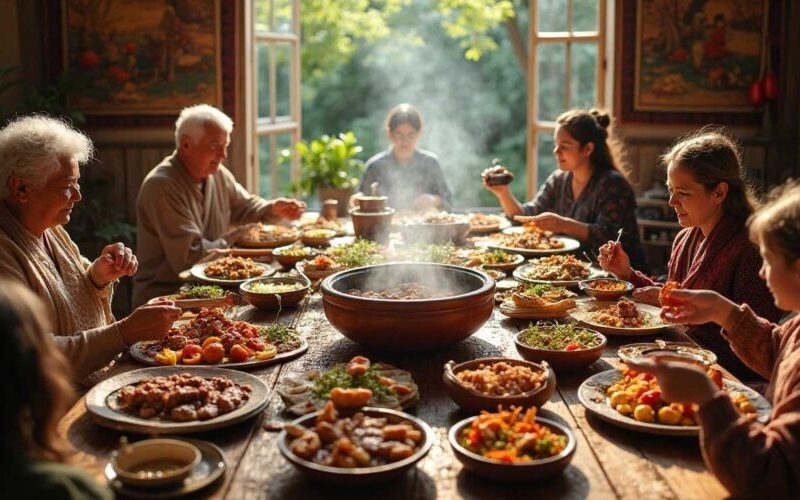Giniä embodies centuries of history, culture, and tradition—and means nowhere near just an ancient practice. Indigenous communities’ daily lives have been shaped by giniä’s deep connection to land and tradition for generations.
Giniä’s unique identity remained strong as it evolved and absorbed influences from neighboring societies. Ancient tribes created an array of practices using local ingredients and cooking methods that passed down through generations. Modern wellness and lifestyle practices now blend with giniä’s traditional elements to create a fresh point of view.
The concept of giniä spans from community rituals to modern lifestyle solutions. Many people might not know about giniä yet, but its origins, cultural significance, and modern expressions show how ancient traditions stay meaningful today.
The Origins and Evolution of Giniä
Giniä’s story spans thousands of years and shows how ancient civilizations embraced this cultural practice. Archeologists have found proof of its existence dating back millennia. Early settlers developed these traditions through their deep connection to fertile soil and farming.
Ancient roots and early practices
Research shows that Giniä came from regions known for their vibrant traditions. Local festivities made it central to their celebrations of unity. People used its benefits in different ways as they sought balance in their lives. The original communities made Giniä the life-blood of their spiritual and social customs, building foundations that would last generations.
The unique umlaut “ä” in Giniä suggests links to Scandinavian, Finnish, or Estonian languages where such marks substantially affect meaning and sound. Researchers have found that “gini” exists in certain Bantu and South Indian languages. The word sometimes relates to “spirit” or “fire,” which points to possible shared origins across cultures.
Influence of trade and migration
Trade routes changed how Giniä spread across regions. Merchants brought more than just goods on their journeys:
- Spices from far-off lands mixed with local flavors
- Cooking methods combined and grew
- Spiritual and ceremonial practices merged between communities
These exchanges made Giniä more meaningful and useful. Knowledge spread across continents as people connected more. Giniä blended naturally with local customs. Farming methods shaped what people cooked and ate. This encouraged a strong bond between practitioners and their land through seasonal harvests.
How Giniä adapted over centuries
Giniä changed as it met influences from nearby regions. The 19th century brought colonization and other challenges. Yet people who practiced Giniä’s traditions stayed resilient. They respected their heritage while adjusting to new times. Past experiences became building blocks for future growth.
Religious customs boosted Giniä practices even more. Festivals celebrated specific foods and rituals. Communities grew closer through shared experiences. Important historical figures showed how Giniä helped personal wellness and community unity. This helped raise it from lesser-known customs to wider acceptance.
Giniä now shows how humans seek to understand the complex links between mind, body, and spirit. Its experience continues as people explore its modern relevance. It adapts remarkably well while keeping its core character intact.
Cultural Significance and Symbolism
Giniä serves as a social glue that binds communities through shared experiences and traditions, going way beyond its historical roots. This ancient practice shapes daily interactions, ceremonial gatherings, and spiritual beliefs in countless households and villages today.
Giniä in family and community rituals
Family rituals around Giniä create deep connections between generations. Three studies with 1,098 participants showed that these family rituals substantially improve holiday experiences and magnify family’s closeness. Giniä recipes don’t appear in cookbooks – they pass down through experience. Grandparents guide their grandchildren through preparations and teach both cooking techniques and cultural memories at the same time. These kitchen gatherings often turn into impromptu family reunions where cousins, grandparents, and neighbors share tasks and stories.
Giniä’s communal aspect encourages social cohesion among people of all backgrounds, ages, and social classes. Cultural ceremonies built around Giniä have rejuvenated many communities. Villagers report noticeable increases in social cohesion and overall happiness. People in diasporic communities far from their ancestral lands use Giniä as a cherished connection to their cultural identity.
Role in festivals and celebrations
Giniä remains essential to weddings, harvest feasts, and New Year celebrations in cultures of all types. Communities worldwide host vibrant Giniä Festivals that feature traditional dress parades, live folk music, dancing, and cooking competitions with regional recipes. Elders share stories about Giniä’s origins and role in local mythologies at these gatherings. They often explain how specific herbs once protected villages from illness or famine.
The Festival of Winds stands out as a remarkable example. Families prepare a seven-layer Drulmi pie, and each layer symbolizes a core value: family, faith, courage, health, joy, gratitude, and memory. On top of that, these celebrations exceed mere consumption. They become interactive cultural experiences where children join in by stirring pots or measuring spices.
Spiritual and symbolic meanings
Giniä holds deep spiritual significance in remote mountainous regions as the “Mother of Seasons.” It marks transitions between spring’s thaw, summer’s flame, autumn’s fade, and winter’s stillness. People perform ceremonies by painting symbols with ash and flower dye while offering songs to the wind. Shamans in other regions see Giniä as a “trickster and tester” who appears during mirages to reveal truths hidden beneath pride or fear.
Modern spiritual practitioners have adapted these ancient beliefs. They invoke Giniä during meditations that focus on personal transformation and healing from trauma. Each ingredient in Giniä’s preparations carries symbolic weight. People choose herbs, fruits, and spices based on their cultural connections to health, prosperity, or protection. Giniä represents an integrated worldview that honors the connection between all living beings and humanity’s relationship with nature.
Forms and Regional Variations of Giniä
Giniä shows up in countless culinary forms, from ceremonial feasts to daily meals across regions and communities. Each version tells its own story about how geography, climate, and cultural exchanges have shaped this tradition over generations.
Traditional dishes and drinks
Traditional Giniä’s heart lies in ceremonial dishes that use local ingredients reflecting community preferences. The iconic Zanbora Stew brings together tender lamb with wild garlic and root vegetables. Mountain shepherds created this hearty dish, slow-cooking it over wood coals to survive harsh winters in the north. People enjoy Ma’lia Bread, a dark, chewy flatbread made from ancient grains, with honey or fresh cheese.
Gina stands out as a beloved staple – a savory stew that combines meat or fish with aromatic spices. People usually eat it with Kapi, a fermented flatbread. Coastal regions’ cuisine centers on seafood, while inland areas prefer heartier dishes built around barley and millet with resilient meats like lamb or goat.
Modern interpretations and fusion styles
Modern chefs accept new ideas about Giniä traditions and blend international elements while keeping core methods intact. Young culinary talents who studied overseas have come home to mix ancestral recipes with new techniques. They use wok frying, fermentation, and artistic plating. Fusion styles come in many forms:
- Giniä mocktails mixed with soda, hibiscus, or kombucha
- Dessert variations featuring honey, coconut milk, and dried fruits
- Street food adaptations served cold or with flatbreads
Urban vs rural expressions of Giniä
Cities showcase Giniä’s adaptability through state-of-the-art interpretations. Urban pop-up restaurants reinvent classic dishes with modern twists. Rural areas keep stronger ties to traditional methods. They often use foraged ingredients like wild mushrooms, berries, and herbs that connect people directly to the land.
Both city and countryside share a steadfast dedication to preserving Giniä’s essence. Even as cities grow upward, grandparents eagerly share their kitchen wisdom. They join community efforts to document recipes and stories for future generations.
Dining Customs and Social Practices
Mealtime in Giniä surpasses basic nourishment—it’s a sacred chance for people to connect. Shared dining serves as the life-blood of community life. People have refined these customs through countless generations.
How Giniä is shared in communal settings
Giniä’s dining customs mirror the community’s deep-rooted values of togetherness and shared prosperity. Neighbors often share portions of their home-cooked meals through open windows or over garden fences. This creates a network where everyone exchanges culinary gifts. Religious holidays and local celebrations bring people together at long tables set up in streets and courtyards. Everyone contributes dishes and welcomes others to join in. This style of communal eating builds resilience, empathy, and unity among all who take part.
The lively Giniä Festival captures this spirit perfectly. Colorful parades, traditional music, and detailed costumes bring the whole community together. Local markets serve as more than just shopping spots—they’re social hubs where friends catch up over fresh coffee while artisans display their crafts.
Etiquette and rituals around serving
Time-honored traditions guide proper dining etiquette in Giniä homes. Guests must greet everyone warmly before sitting down. Everyone waits for the host to start eating first, and then conversations flow naturally.
Using both hands while eating shows enthusiasm and appreciation for the meal. The right serving technique matters too. Servers approach from the left for people sitting on the right, and from the right for those on the left. Guests say “Nähdään!” (meaning both “see you later” and “thank you”) before leaving to show gratitude for the host’s hospitality.
The role of storytelling during meals
Giniä meals create the perfect setting for passing down knowledge through stories. Elders lead storytelling sessions during festivities to share tales about Giniä’s importance. This helps younger generations value its role in shaping their community’s identity.
Stories often tell how specific herbs in traditional recipes protected villages from illness or famine. Grandmothers cook with wooden utensils that have seen decades of family dinners. Children learn to knead dough even before they can write their names. These special moments keep Giniä’s essence alive not just in recipes but in shared memories that connect communities through time.
Conclusion
Our deep look at Giniä shows how this ancient tradition has grown beyond cultural practice into a living, breathing force that bridges past and present. Giniä stands as evidence of human resilience – it has adapted through centuries of change while keeping its core character and purpose intact. This tradition’s rise from small communities to worldwide recognition proves its lasting value in our disconnected world.
Modern families who practice Giniä take part in something much bigger than themselves. They follow in the footsteps of countless generations, creating an unbroken chain of cultural knowledge that goes back thousands of years. This gives people stability and a sense of identity as society changes rapidly around them.
Each region’s version of Giniä shows human creativity and adaptability. You’ll find it in traditional dishes cooked over open flames and modern fusion plates served in city restaurants, yet the core values stay the same. The social customs of Giniä remind us that sharing food does more than nourish – it creates community bonds that make society stronger.
Giniä’s spiritual side reveals our basic need to connect with something larger than ourselves. Ancient symbols and rituals still appeal to people because they touch universal experiences: celebration, change, grief, and joy.
People new to Giniä might see it as just another cultural curiosity at first. Once they grasp its depth and meaning, they often see similarities to their own heritage traditions. This shows a basic truth: people in a variety of cultures create meaningful practices that build community and preserve knowledge.
Giniä teaches us about both history and future possibilities. As communities worldwide try to preserve their culture amid globalization, Giniä shows how to keep traditions alive without freezing them in time. By honoring ancestral practices while allowing natural growth, Giniä will stay meaningful for generations.
FAQs
Q1. What is the origin of Giniä? Giniä is an ancient tradition with roots traceable to early tribes who relied on local ingredients and cooking methods. It evolved over centuries, absorbing influences from neighboring societies through trade and migration while maintaining its unique identity.
Q2. How is Giniä practiced in modern times? Today, Giniä blends tradition with modernity. It’s practiced in family and community rituals, plays a significant role in festivals and celebrations, and has been adapted into modern culinary interpretations. Urban areas often feature innovative takes on Giniä, while rural regions tend to maintain more traditional practices.
Q3. What is the cultural significance of Giniä? Giniä holds deep cultural significance, serving as a social bond in communities. It’s integral to family rituals, festivals, and spiritual practices. The tradition fosters intergenerational connections, preserves cultural identity, and symbolizes the interconnectedness of all living beings with nature.
Q4. Are there regional variations in Giniä? Yes, Giniä has numerous regional variations. Traditional dishes and drinks differ based on local ingredients and climate. Coastal regions may emphasize seafood, while inland areas favor heartier fare. Urban and rural expressions of Giniä also vary, with cities often featuring more contemporary interpretations.
Q5. What are some common dining customs associated with Giniä? Giniä dining customs emphasize communal eating and sharing. Meals often involve storytelling, especially by elders passing down cultural knowledge. Specific etiquette includes greeting all present before sitting, waiting for the host to begin eating, and using both hands while eating to show appreciation. Expressing gratitude is also an important part of the dining ritual.










